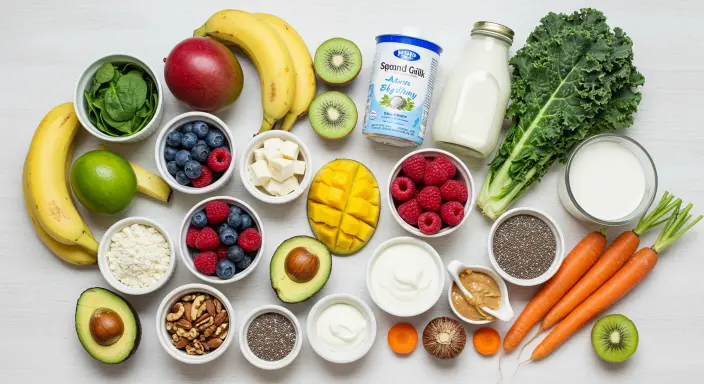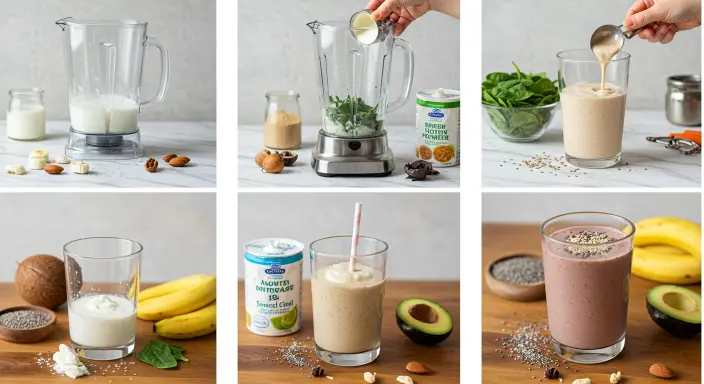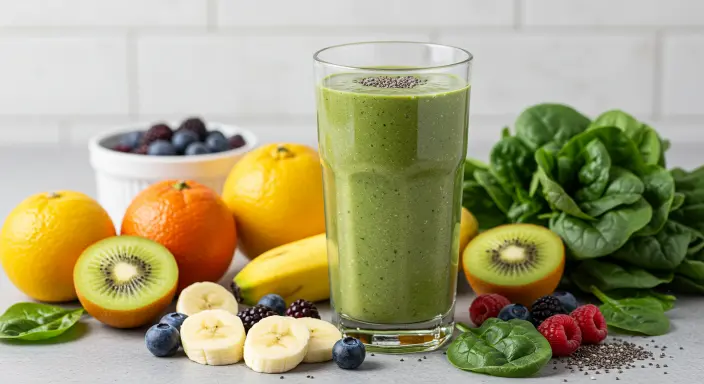How to Make the Ultimate Healthy Breakfast Smoothie: A Delicious Guide
Welcome to your ultimate guide on crafting the perfect healthy breakfast smoothie! If you’re in search of a quick, nutritious way to kickstart your day, smoothies are an excellent solution. Not only are they delicious, but they also pack a powerful nutritional punch, providing you with essential vitamins, minerals, and energy to fuel your morning. In this article, I’ll share my favorite recipes, tips for making the best smoothies, and insights into the health benefits of incorporating smoothies into your breakfast routine. Whether you are a busy professional, a health enthusiast, or a parent looking to feed your kids nutritious meals, this guide is for you!
Key Aspects of Healthy Breakfast Smoothies
Healthy breakfast smoothies are more than just a trendy food option; they are a versatile meal that can cater to various dietary needs and preferences. A well-balanced smoothie typically includes a combination of fruits, vegetables, protein, and healthy fats. By understanding the key components, you can tailor your smoothie to meet your nutritional goals.
Nutritional Components of a Healthy Smoothie
- Fruits: Fruits are the foundation of most smoothies, providing natural sweetness and a host of vitamins. Bananas, berries, mangoes, and apples are popular choices. They add flavor and essential nutrients like vitamin C and fiber.
- Vegetables: While it may seem unconventional, adding vegetables to your smoothies can dramatically increase their nutritional value. Leafy greens like spinach and kale are excellent choices, as they are low in calories but high in vitamins and minerals. Avocado is another great addition, providing healthy fats and a creamy texture.
- Liquid Base: The liquid you choose is crucial for achieving the right consistency. Almond milk, coconut water, or yogurt can be used to create a smooth and creamy base. For those looking for a dairy-free option, plant-based milks are widely available.
- Protein Source: Including a protein source in your smoothie helps keep you full longer and supports muscle repair and growth. Greek yogurt, protein powder, nut butter, or silken tofu are all excellent options that can enhance the nutritional profile of your smoothie.
- Healthy Fats: Adding healthy fats can improve the texture of your smoothie and provide additional health benefits. Chia seeds, flaxseeds, and avocado are great sources of omega-3 fatty acids, which are essential for heart health.
Ingredients You’ll Need for the Ultimate Healthy Breakfast Smoothie
Creating the ultimate healthy breakfast smoothie is all about balance and personal preference. Here’s a list of ingredients to consider:
- Fruits:
- Bananas: Great for creaminess and natural sweetness.
- Berries: Blueberries, strawberries, and raspberries are rich in antioxidants.
- Mango: Adds tropical flavor and vitamin A.
- Pineapple: Provides a refreshing taste and vitamin C.
- Vegetables:
- Spinach: Mild in flavor and rich in iron and vitamins.
- Kale: Nutrient-dense and adds a vibrant green color.
- Avocado: Adds creaminess and healthy fats.
- Carrots: Sweet and rich in beta-carotene.
- Liquid Base:
- Almond Milk: Low in calories and a great dairy alternative.
- Coconut Water: Hydrating and slightly sweet.
- Greek Yogurt: Adds protein and creaminess.
- Fruit Juice: Use sparingly for added sweetness.
- Protein Source:
- Greek Yogurt: High in protein and probiotics.
- Protein Powder: Whey, casein, or plant-based options.
- Nut Butter: Almond or peanut butter for healthy fats.
- Silken Tofu: Adds protein and a smooth texture.
- Healthy Fats:
- Chia Seeds: High in fiber and omega-3 fatty acids.
- Flaxseeds: Great source of lignans and healthy fats.
- Nut Butters: Almond or cashew butter for creaminess.
- Coconut Oil: Adds healthy fats and a tropical flavor.

Step-by-Step Instructions to Make the Ultimate Healthy Breakfast Smoothie
Making a smoothie is simple and can be done in just a few minutes. Here’s a step-by-step guide to help you create the perfect blend:
- Choose Your Base: Start with a liquid base of your choice. Pour about 1 cup into your blender. This could be almond milk, coconut water, or yogurt, depending on your preference.
- Add Fruits and Vegetables: Next, add 1-2 cups of your favorite fruits and vegetables. I love using a banana for sweetness and spinach for an extra nutrient boost. You can combine different ingredients according to what you have available.
- Incorporate Protein: Add a scoop of protein powder or a dollop of Greek yogurt to keep you full longer. This step is essential if you want your smoothie to serve as a meal replacement.
- Include Healthy Fats: Toss in a tablespoon of chia seeds or a slice of avocado for a creamy texture and healthy fats. This will help you feel satisfied and provide lasting energy.
- Blend Until Smooth: Blend on high until all ingredients are well combined and smooth. If the mixture is too thick, add more liquid to reach your desired consistency. Remember, the key is to achieve a creamy and drinkable texture.
- Taste and Adjust: Taste your smoothie and adjust sweetness or thickness as needed. You can add honey, maple syrup, or a splash of vanilla extract for extra flavor if desired.
- Serve and Enjoy: Pour your smoothie into a glass, garnish with seeds or nuts on top, and enjoy your delicious, healthy breakfast!

Nutritional Value
Understanding the nutritional value of your smoothie ingredients is essential for making informed choices. Here’s a breakdown of some common ingredients and their benefits:
| Ingredient | Benefits |
|---|---|
| Banana | High in potassium, aids digestion, and provides natural sweetness. |
| Spinach | Rich in iron, vitamins A and C, and antioxidants. |
| Greek Yogurt | High in protein, probiotics for gut health, and adds creaminess. |
| Chia Seeds | Packed with omega-3 fatty acids, fiber, and protein. |
| Avocado | Provides healthy monounsaturated fats, fiber, and potassium. |
Benefits of Healthy Breakfast Smoothies
Incorporating healthy breakfast smoothies into your daily routine offers numerous benefits:
- Convenience: Smoothies are quick to prepare and can be taken on the go. This makes them a perfect choice for hectic mornings..
- Nutrient-Dense: They provide a concentrated source of vitamins, minerals, and antioxidants, helping you meet your daily nutritional needs.
- Versatility: You can customize ingredients to fit your taste and dietary needs. Whether you’re vegan, gluten-free, or looking for low-calorie options, there’s a smoothie for everyone.
- Weight Management: Smoothies can be filling and help control hunger, making them a great option for those looking to maintain or lose weight.
- Boosts Energy: The combination of fruits, vegetables, and proteins provides a balanced source of energy that can keep you feeling energized throughout the morning.
- Improves Digestion: Ingredients like yogurt and chia seeds are rich in probiotics and fiber, promoting a healthy digestive system.
- Supports Immunity: The vitamins and antioxidants found in fruits and vegetables can help boost your immune system, keeping you healthy.
Overcoming Challenges
Making smoothies can sometimes lead to challenges, such as achieving the right texture or flavor. Here are some practical tips to help you overcome these common issues:
- Texture Troubles: If your smoothie is too thick, gradually add more liquid (water, milk, or juice) until you reach your desired consistency. Conversely, if it’s too thin, add more fruits or vegetables to thicken it up.
- Flavor Fixes: If your smoothie tastes bland, try adding a pinch of salt or spices like cinnamon or ginger to enhance the flavor. Sweeteners like honey, maple syrup, or dates can also help elevate the taste.
- Ingredient Substitutions: If you’re out of a specific ingredient, don’t hesitate to substitute! For example, if you don’t have bananas, you can use applesauce or yogurt to add creaminess.
- Avoiding Oxidation: If you make your smoothie in advance, store it in an airtight container in the fridge to prevent oxidation and preserve freshness. A splash of lemon juice can also help maintain color and flavor.
Future Trends in Smoothies
As health consciousness continues to rise, the smoothie trend is evolving. Here are some predictions for the future of smoothies:
- Increased Use of Superfoods: Expect to see more superfoods like spirulina, acai, and matcha being incorporated into smoothies for their added health benefits.
- More Plant-Based Options: As more people adopt plant-based diets, smoothies will increasingly feature ingredients like nut milks, plant-based protein powders, and dairy alternatives.
- Innovations in Smoothie-Making Technology: New blender technologies and smart kitchen appliances will make it easier to create smoothies quickly and efficiently, even on-the-go.
- Personalized Nutrition: With advancements in nutrition science, smoothies may become more personalized based on individual health goals, preferences, and dietary restrictions.
- Sustainability Focus: As consumers become more environmentally conscious, there will be a push for sustainable sourcing of ingredients and eco-friendly packaging for smoothie products.
Tips and Tricks Section
To help you make the most of your smoothie-making experience, here are some valuable tips and tricks:
- Prep Ahead: Prepare smoothie bags with pre-measured ingredients and freeze them for quick blending in the morning.This helps you save time and guarantees that you have nutritious choices readily available.
- Use Frozen Fruits: Frozen fruits not only provide a creamy texture but also eliminate the need for ice, which can dilute the flavor. They are also convenient and often more affordable than fresh fruit.
- Experiment with Flavors: Don’t be afraid to get creative! Add spices like cinnamon, nutmeg, or ginger for a flavor boost without extra calories. Fresh herbs like mint or basil can also add a refreshing twist.
- Make it a Meal: To transform your smoothie into a complete meal, consider adding oats, nut butter, or seeds. These additions provide extra fiber and protein, making your smoothie more filling.
- Garnish for Presentation: A little garnish can go a long way! Top your smoothie with seeds, nuts, or granola for added texture and visual appeal. It makes your smoothie feel more like a treat!
Variations and Adaptations
Smoothies are incredibly versatile, and there are countless ways to adapt them to suit different dietary needs or preferences. Here are some variations to consider:
- Gluten-Free: All smoothies can easily be made gluten-free by choosing gluten-free protein powders or bases. Most fruits and vegetables are naturally gluten-free.
- Vegan Options: Use plant-based yogurt and milk to create delicious vegan smoothies. Additionally, opt for nut butters that are free from animal products.
- Low-Calorie: For a lower-calorie option, use water or unsweetened almond milk as a base, and focus on low-calorie fruits like berries and leafy greens.
- Protein-Packed Smoothie: If you’re looking to up your protein intake, consider adding additional protein powder, Greek yogurt, or even cottage cheese for a creamy texture.
- Dessert Smoothies: For a treat, create dessert-inspired smoothies by adding ingredients like cocoa powder, peanut butter, or frozen yogurt. These can satisfy your sweet tooth while still providing nutritional benefits.
FAQs Section
Here are some common questions about smoothies, along with helpful answers:
Can I make smoothies in advance?
Yes, smoothies can be prepared ahead of time and stored in the fridge for up to 24 hours. Just give them a good shake before drinking.
What can I substitute for yogurt?
You can use plant-based yogurt, silken tofu, or even avocado for creaminess. Each option will bring a different flavor and texture to your smoothie
How do I store leftover smoothies?
Store any leftover smoothie in an airtight container in the fridge for up to a day. For longer storage, consider freezing portions in ice cube trays or freezer-safe containers.
Can smoothies help with weight loss?
Yes, smoothies can be a helpful tool for weight loss when made with whole, nutritious ingredients. They can keep you satisfied and help control cravings, especially when packed with protein and fiber.
Are smoothies good for kids?
Absolutely! Smoothies can be a great way to sneak in fruits and vegetables for kids. Involve them in the process by letting them choose their favorite ingredients for a fun and healthy breakfast.
Conclusion
In conclusion, making the ultimate healthy breakfast smoothie is not only simple but also incredibly rewarding. With the right ingredients and a little creativity, you can whip up a delicious and nutritious smoothie that will kickstart your day. I encourage you to experiment with different flavors and textures to find your perfect blend. Smoothies are a fantastic way to nourish your body, boost your energy, and enjoy a quick meal on busy mornings. Don’t forget to share your smoothie creations and tips in the comments below!

